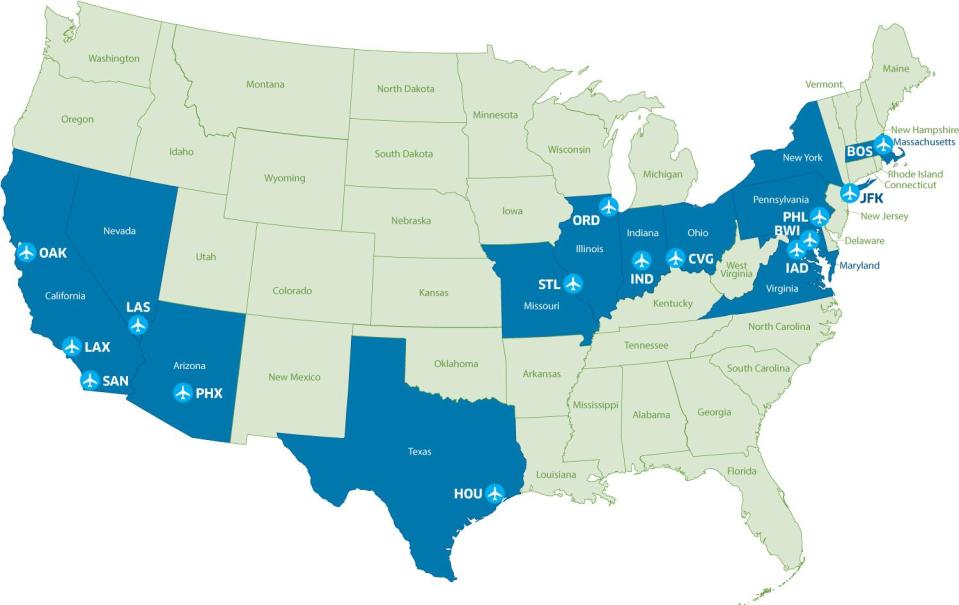TSA Tests 3D Scanners for Carry-On Bags at 15 Major Airports

By now, anyone who’s traveled by plane knows to arrive at least an hour-and-a-half to two hours before their flight to deal with the long security lines and longer waits at major airports in the U.S. Created in the wake of the Sep. 11 attacks, the Transportation Safety Administration's main task is to ensure travelers don't have anything more troublesome to worry about than boring in-flight entertainment or a seat mate who hogs the armrest. While air travel as we know it has turned into a real slog for flyers, the TSA has begun rolling out a new kind of scanner for carry-on luggage that can cut down on both the length of time you go through security checks and the amount of time you have to stand in line.
According to the TSA's website, these new Computed Tomography (CT) scanners (the same type of machine hospitals use to take a good look at your insides) will take the place of the standard X-ray machines currently used to check carry-on luggage in the following 15 airports in the next few months, all of them major hubs:
Baltimore-Washington International Airport (BWI)
Chicago O’Hare International Airport (ORD)
Cincinnati/Northern Kentucky International Airport (CVG)
Houston Hobby Airport (HOU)
Indianapolis International Airport (IND)
John F. Kennedy International Airport (JFK)
Logan International Airport (BOS)
Los Angeles International Airport (LAX)
McCarran International Airport (LAS)
Oakland International Airport (OAK)
Philadelphia International Airport (PHL)
Phoenix Sky Harbor International Airport (PHX)
San Diego International Airport (SAN)
St. Louis Lambert International Airport (STL)
Washington-Dulles International Airport (IAD)

Map of airports included in the planned CT scanner rollout from TSA
Why these new scanners will cut down your wait
The benefit of these new scanners is that they allow agents to see a 3D image of the contents of your carry-on luggage, allowing them to distinguish your family-size bag of Sour Patch kids from an IED without pulling you out of line and rummaging through your carefully-packed items. Currently the flat, 2-D images provided by most airport X-ray machines makes it difficult for screeners to get a clear picture of what's in your carry-on, especially when you pack anything that obscures the image (such as books or packages of food) or that resembles explosive material (such as any kind of powder or liquid), which usually results in a manual search. "We think in perhaps five years or so, the passengers won't have to take anything out of their carry-on bags," TSA head David Pekoske told CBS News.
How you can spend less time in the airport now (or at least make it more pleasant).
The TSA plans on having 145 of the CT scanners in service by the end of fiscal year 2019, but if you want to get a jump start on cutting down on the time you wait in security, there are a few options readily available:
Apply for TSA Pre-Check: Created by the TSA in 2011 for low-risk travelers, this program allows approved applicants access to an expedited screening process. For the most part, TSA Pre-Check travelers can keep on outerwear and their shoes and belts, avoid taking out their laptops and even travel with some liquids. It's like boarding a plane back in the 1990s. If you're interested in joining the program, know that you need to show up at an enrollment center, pay a non-refundable $85 application fee, and provide the TSA with fingerprints, and Social Security number for a background check. If approved, you are good to go for 5 years, at which point you can apply to renew your status.
Apply for a Premium Credit Card: While the travel benefits should never be the primary reason you to apply for a credit card carrying annual fees you can't afford, certain premium cards offer services that make traveling through airports easier (if not always quicker) and are worth a look if you're in the market for a premium card anyway. These cards can't promise you a faster path through security, but they do offer all sorts of benefits such as luxury lounge access once you are past TSA, free checked bags and more. The annual fees of these cards can run you around $500 (or more) and generally require excellent credit. they also can make flying so carefree, especially if you’re a frequent flier, that you won't even mind waiting in the security line.

 Yahoo Finance
Yahoo Finance 